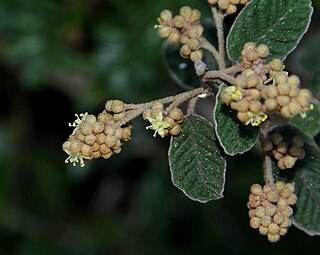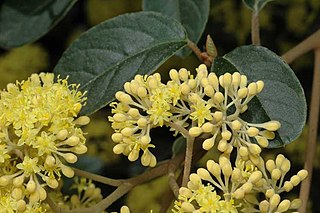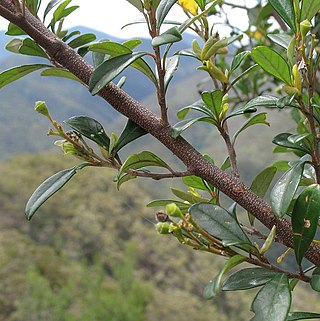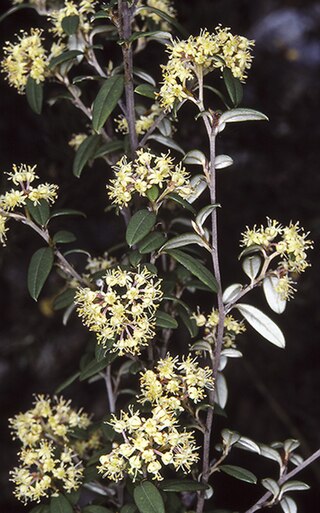
Pomaderris intermedia, commonly known as lemon dogwood, is a species of flowering plant in the family Rhamnaceae and is endemic to south-eastern Australia. It is a shrub with hairy stems, elliptic to egg-shaped leaves, and clusters of yellow flowers.

Pomaderris oraria, commonly known as Bassian dogwood, is a species of flowering plant in the family Rhamnaceae and is endemic to south-eastern Australia. It is a compact shrub with hairy branchlets, hairy, elliptic leaves and panicles of hairy, greenish to cream-coloured or crimson-tinged flowers.

Pomaderris paniculosa, commonly known as scurfy pomaderris, is a species of flowering plant in the family Rhamnaceae and is native to Australia and New Zealand. It is a shrub with hairy branchlets, round to elliptic or egg-shaped leaves with the narrower end towards the base and panicles of hairy, cream-coloured to greenish, sometimes crimson-tinged flowers.

Pomaderris lanigera, commonly known as woolly pomaderris, is a species of flowering plant in the family Rhamnaceae and is endemic to south-eastern continental Australia. It is a shrub or small tree with hairy stems, lance-shaped to egg-shaped or elliptic leaves, and hemispherical clusters of yellow flowers.

Pomaderris elliptica, commonly known as yellow dogwood or smooth pomaderris, is a species of flowering plant in the family Rhamnaceae and is endemic to south-eastern Australia. It is a shrub with densely hairy branchlets, egg-shaped or elliptic leaves, and pale yellow flowerss.

Pomaderris aurea is a species of flowering plant in the family Rhamnaceae and is endemic to Victoria, Australia. It is a shrub with hairy branchlets, egg-shaped or elliptic leaves and panicles of golden yellow flowers.

Pomaderris bodalla, commonly known as Bodalla pomaderris, is a species of flowering plant in the family Rhamnaceae and is endemic to New South Wales. It is a shrub with hairy young stems, elliptic to more or less rhombic leaves, and dense clusters of cream-coloured flowers.
Pomaderris briagolensis is a species of flowering plant in the family Rhamnaceae and is endemic to Victoria, Australia. It is a shrub with hairy branchlets, egg-shaped or oblong leaves and panicles of white to rust-coloured flowers.

Pomaderris cocoparrana, commonly known as Cocoparra pomaderris, is a species of flowering plant in the family Rhamnaceae and is endemic to a restricted area of New South Wales. It is a shrub with hairy stems, egg-shaped to more or less round leaves, and clusters of yellow flowers.
Pomaderris coomingalensis is a species of flowering plant in the family Rhamnaceae and is endemic to Queensland. It is a shrub with hairy young stems, egg-shaped or elliptic leaves, and clusters of cream-coloured or yellow flowers.

Pomaderris cotoneaster, commonly known as cotoneaster pomaderris, is a species of flowering plant in the family Rhamnaceae and is endemic to south-eastern continental Australia. It is an erect shrub with woolly-hairy stems, elliptic leaves, and leafy panicles of cream-coloured flowers.

Pomaderris gilmourii is a species of flowering plant in the family Rhamnaceae and is endemic to Deua National Park in New South Wales. It is a shrub with hairy young stems, egg-shaped to elliptic leaves, and clusters of silvery buds and creamy-yellow flowers.

Pomaderris helianthemifolia is a species of flowering plant in the family Rhamnaceae and is endemic to south-eastern continental Australia. It is a bushy shrub with hairy young stems, narrowly elliptic to lance-shaped leaves with the narrower end towards the base, and small panicles of hairy yellowish flowers.

Pomaderris ledifolia, commonly known as Sydney pomaderris, is a species of flowering plant in the family Rhamnaceae and is endemic to south-eastern continental Australia. It is an erect, delicate shrub with hairy young stems, narrowly elliptic to lance-shaped leaves, and compact clusters of yellow flowers.

Pomaderris ligustrina, commonly known as privet pomaderris, is a species of flowering plant in the family Rhamnaceae and is endemic to south-eastern continental Australia. It is a shrub with hairy stems, lance-shaped to narrowly elliptic leaves, and loose clusters of cream-coloured or yellow flowers.

Pomaderris parrisiae is a species of flowering plant in the family Rhamnaceae and is endemic to southern New South Wales. It is a shrub to small, slender tree with silvery-hairy branchlets, elliptic to lance-shaped leaves and panicles of hairy, creamy-yellow flowers.

Pomaderris racemosa is a species of flowering plant in the family Rhamnaceae and is endemic to south-eastern Australia. It is a shrub or small tree with densely hairy branchlets, egg-shaped to broadly elliptic leaves, and racemes or panicles of cream-coloured flowers.

Pomaderris reperta, commonly known as Denman pomaderris, is a species of flowering plant in the family Rhamnaceae and is endemic to a restricted area of New South Wales. It is a shrub with densely rusty-hairy new growth, egg-shaped to elliptic leaves, and dense panicles of cream-coloured flowers.
Pomaderris subplicata, commonly known as concave pomaderris, is a species of flowering plant in the family Rhamnaceae and is endemic to Victoria in Australia. It is a shrub with softly-hairy branchlets, egg-shaped leaves, sometimes with the narrower end towards the base, and small clusters of pale yellow flowers.
Pomaderris virgata, commonly known as upright pomaderris, is a species of flowering plant in the family Rhamnaceae and is endemic to south-eastern continental Australia. It is an erect, slender shrub with hairy branchlets, lance-shaped, narrowly elliptic or oblong leaves, and dense panicles of golden-yellow flowers.

















